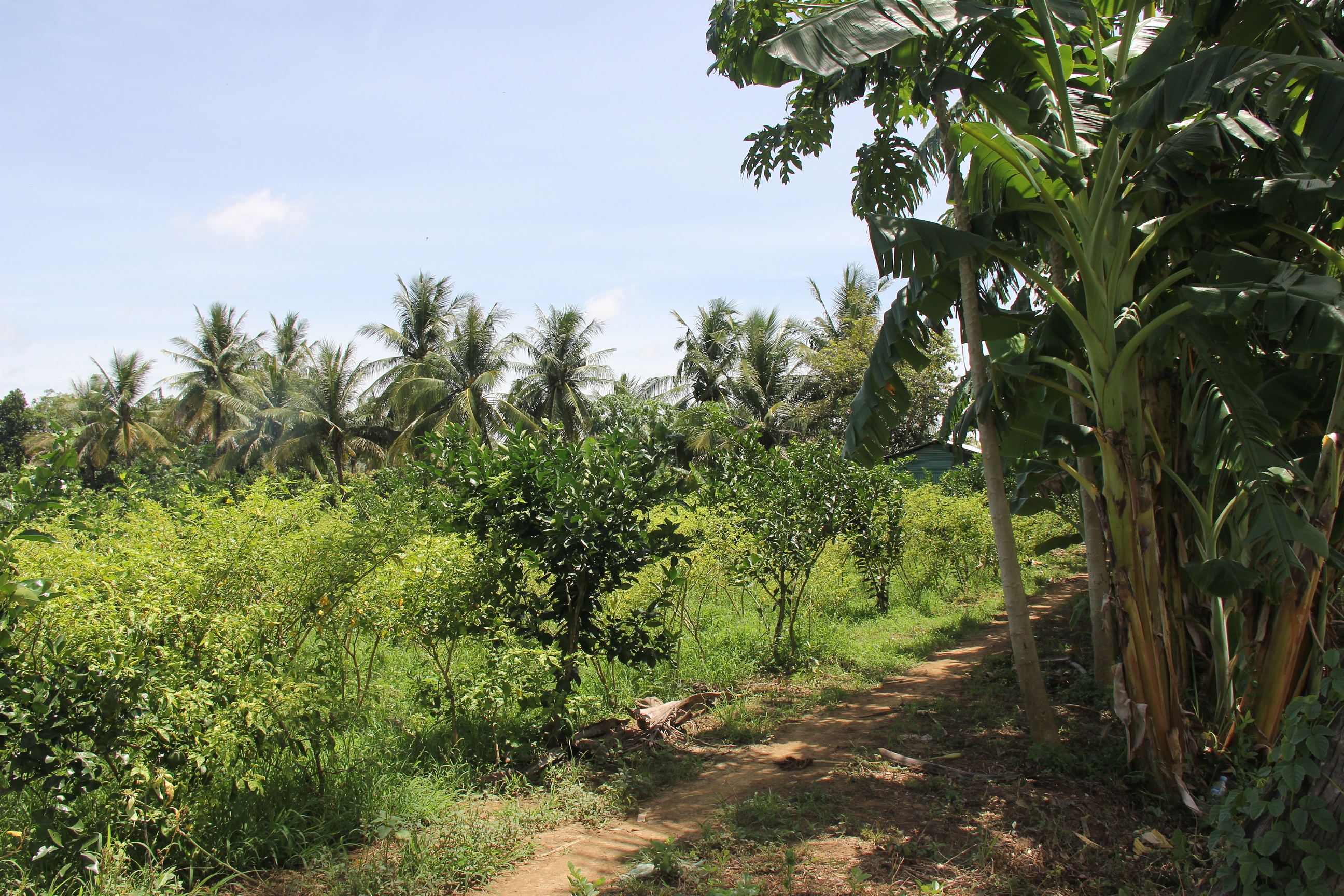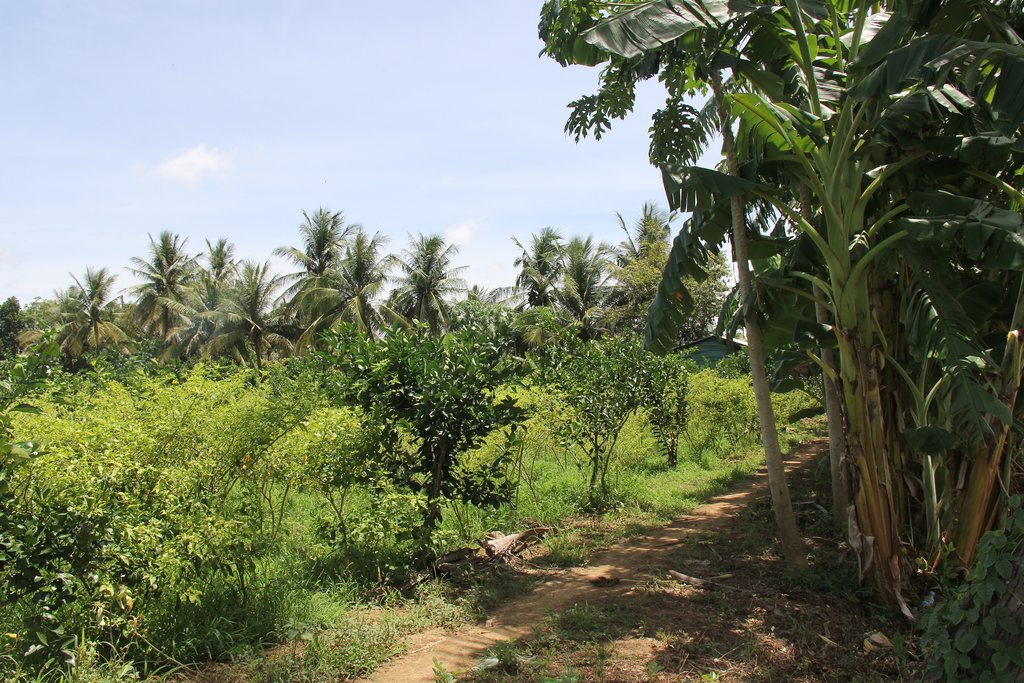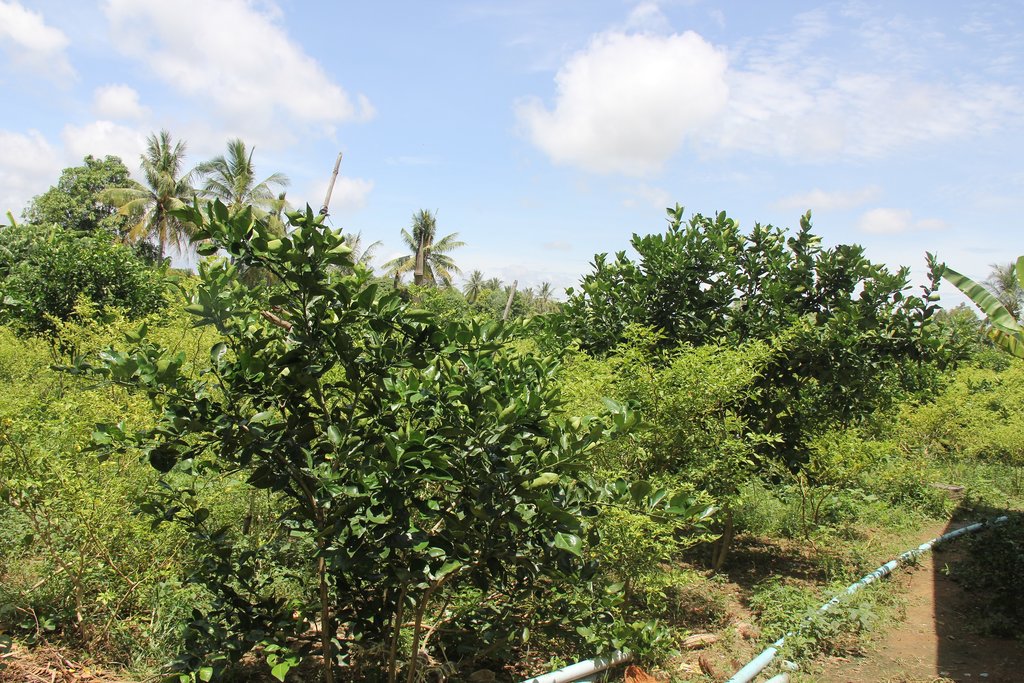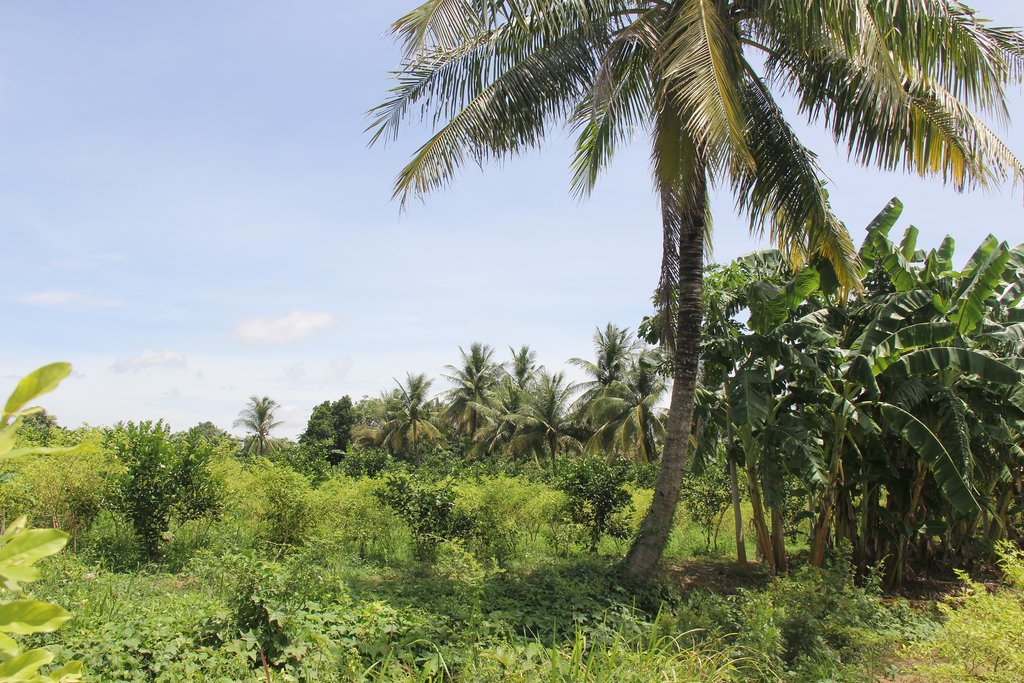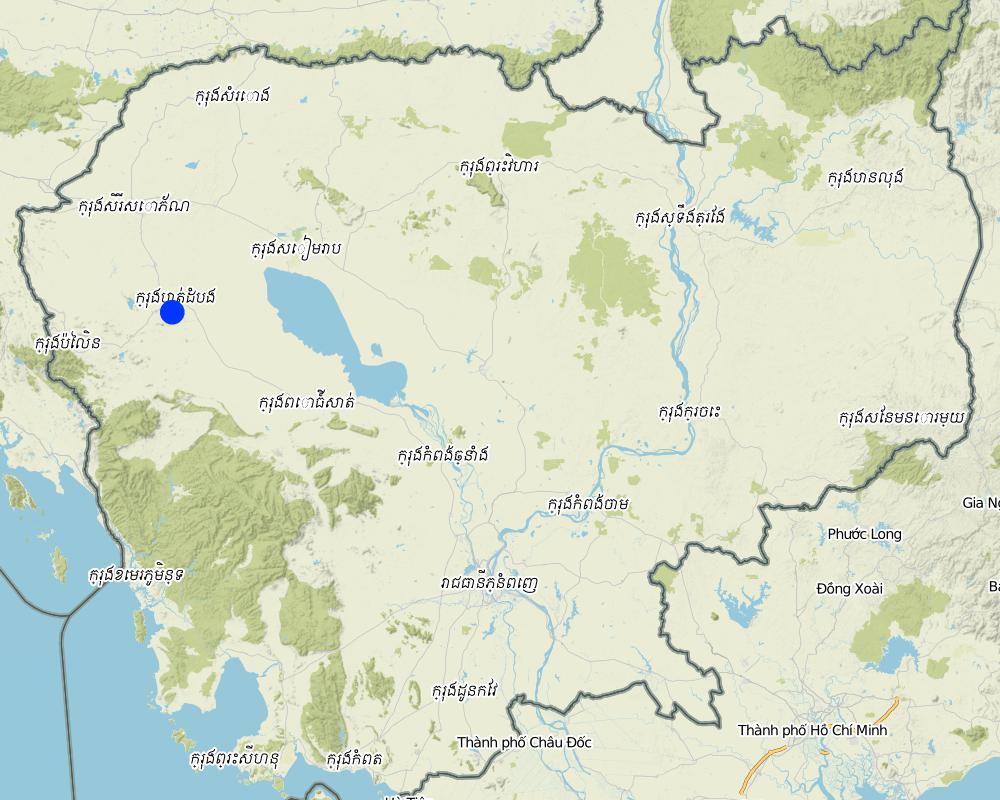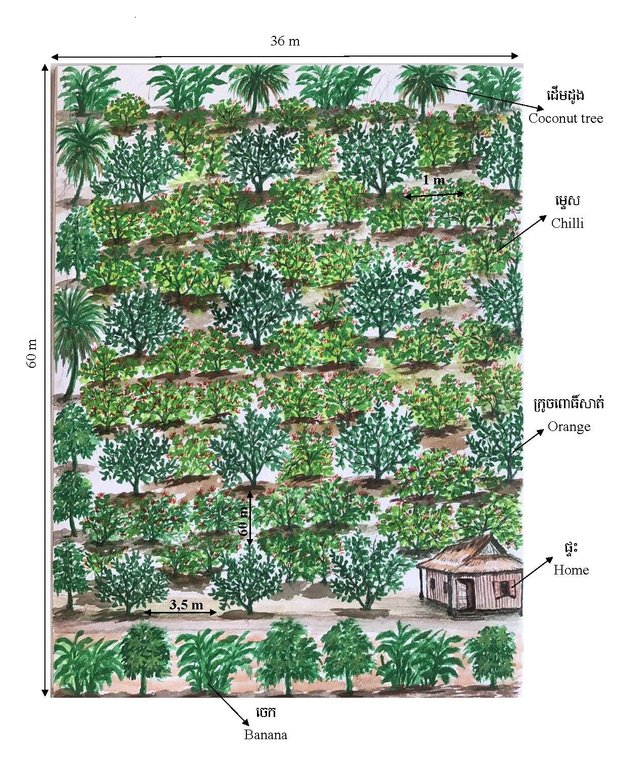Agroforestry: Intercropping of vegetables between orange trees [Cambodia]
- Creation:
- Update:
- Compiler: Be Gechkim
- Editors: Sophea Tim, Navin Chea
- Reviewers: Nicole Harari, SO Than, Stephanie Jaquet, Ursula Gaemperli, Alexandra Gavilano
Mixed cropping
technologies_3171 - Cambodia
View sections
Expand all Collapse all1. General information
1.2 Contact details of resource persons and institutions involved in the assessment and documentation of the Technology
Key resource person(s)
land user:
Rerb Rorn
Farmer
Cambodia
Agronomy Official at District Office of Agriculture, Forestry and Fisheries, Bavel:
Larm Mout
District Office of Agriculture, Forestry and Fisheries, Bavel
Cambodia
Chief of Agricultural Extension Official at District Office of Agriculture, Forestry and Fisheries, Sankae:
Agricultural Extension Official at District Office of Agriculture, Forestry and Fisheries, Thma Koul:
Dara Phusar Siv
District Office of Agriculture, Forestry and Fisheries, Thma Koul
Cambodia
Name of project which facilitated the documentation/ evaluation of the Technology (if relevant)
Scaling-up SLM practices by smallholder farmers (IFAD)Name of the institution(s) which facilitated the documentation/ evaluation of the Technology (if relevant)
Royal University of Agriculture (RUA) - Cambodia1.3 Conditions regarding the use of data documented through WOCAT
The compiler and key resource person(s) accept the conditions regarding the use of data documented through WOCAT:
Yes
1.4 Declaration on sustainability of the described Technology
Is the Technology described here problematic with regard to land degradation, so that it cannot be declared a sustainable land management technology?
No
2. Description of the SLM Technology
2.1 Short description of the Technology
Definition of the Technology:
Intercropping of chilies (or other short-term crops) between young orange trees is a type of agro-forestry system which increases income, makes ultimate use of land resources, saves time for maintenance and irrigation, and improves soil fertility by using crop residue with cow manure as fertilizer, thereby reducing the use of chemicals.
2.2 Detailed description of the Technology
Description:
Chili can be seen as a short-term crop that can be harvested soon after plantation. Farmers plant such short term crops to support their family’s income (Pov, 2016). Oranges are a long-term crop that can be fully harvested after six years and then continue to be harvested for a long time. The more the orange trees are mature, the more they are able to produce. Furthermore, they do not require a great deal of maintenance and there is a good market demand for oranges (CEDAC, 2011). Growing chilies between young orange trees is known as an agro-forestry system that gives rise to a great number of benefits including an increase in the efficiency of land use, a saving of time otherwise spent on maintenance and irrigation, and also it improves the soil quality and prevents land degradation. Moreover it is an improvement in crop production that helps to generate more income for farmers (ECHO, 2007).
The purpose of implementing this technology, whereby other short-term crops (such as chilies, eggplants, and herbs) are seasonally intercropped between young orange trees is to economize time spent on maintenance, watering, and applying fertilizer on chilies. And oranges benefit, too. Assorted crops absorb different nutrients from the soil which enables the soil to remain balanced and fertile and also they do not interfere with the growth of the long-term crop. Additionally the use of crop residue with cow manure is a mean of improving the soil’s fertility and it helps to reduce the use of chemical fertilizer. Alternatively this technology can also include the plantation of papaya and banana trees around the land as additional crops, which provide shade and help to control soil moisture for the other crops.
The farmer needs to plough the soil three times. After the first ploughing the soil has to be dried for four days, after the second ploughing for five days and after the final ploughing it should be dried seven days. If there is additional rainfall then extra days will be needed to get the soil dry. After that, holes need to be dug at a distance of 3.5 meters from each other in any direction. Each hole measures 30 X 40 centimeters and is 30 centimeters in depth. . Before the orange trees are planted the soil should be mixed with compost, consisting of vegetables or crop residue and cow manure. Twenty-five to thirty days after the chilies have sprouted they should be planted between the trees in a row with a gap of 1.2 meters and a distance of one meter from side to side. 2 month later the around 270 chilies plants are able to produce a yield of around 50 to 60 kg.. Once they are four to five months old, 100 to 200 kg can be harvested every 15 days for a period of 6 months. The market price of chilies is between 2000 to 4000 riel per kilogram.
One of the main advantages stated by the land user is to be able to balance the land shortage by using all of free space within the orange orchard. Another advantage is that weeds have less chance to grow. This saves labor time and generates better income. Due to crop rotation (different seasonal crops) he can maintain a good soil quality through a balanced absorption of the soil nutrients.
2.3 Photos of the Technology
2.4 Videos of the Technology
Comments, short description:
N/A
Name of videographer:
N/A
2.5 Country/ region/ locations where the Technology has been applied and which are covered by this assessment
Country:
Cambodia
Region/ State/ Province:
Sangkae district, Battambang province
Further specification of location:
Kampong Chlang village, Voat Ta Muem commune
Specify the spread of the Technology:
- evenly spread over an area
If the Technology is evenly spread over an area, specify area covered (in km2):
0.00216
If precise area is not known, indicate approximate area covered:
- < 0.1 km2 (10 ha)
Comments:
Applied on land of 36m × 60m= 2160 square meters.
Map
×2.6 Date of implementation
Indicate year of implementation:
2016
2.7 Introduction of the Technology
Specify how the Technology was introduced:
- through land users' innovation
Comments (type of project, etc.):
Even though land is small, the farmer finds strategies to earn more income.
3. Classification of the SLM Technology
3.1 Main purpose(s) of the Technology
- improve production
- reduce, prevent, restore land degradation
- create beneficial economic impact
3.2 Current land use type(s) where the Technology is applied
Land use mixed within the same land unit:
Yes
Specify mixed land use (crops/ grazing/ trees):
- Agroforestry

Cropland
- Annual cropping
- Perennial (non-woody) cropping
- Tree and shrub cropping
Annual cropping - Specify crops:
- medicinal/ aromatic/ pesticidal plants and herbs
- chili, eggplant
Annual cropping system:
Vegetables - wheat/barley/oat/upland rice
Perennial (non-woody) cropping - Specify crops:
- flower crops - perennial
Tree and shrub cropping - Specify crops:
- citrus
Number of growing seasons per year:
- 2
Specify:
Chili and other crops
Is intercropping practiced?
Yes
Is crop rotation practiced?
Yes

Forest/ woodlands
Comments:
Oranges trees, chili and other short-term crops like eggplants and herbs.
3.3 Has land use changed due to the implementation of the Technology?
Has land use changed due to the implementation of the Technology?
- Yes (Please fill out the questions below with regard to the land use before implementation of the Technology)

Cropland
- Tree and shrub cropping
Tree and shrub cropping - Specify crops:
- mango, mangosteen, guava
Comments:
Mango trees plantation land
3.4 Water supply
Water supply for the land on which the Technology is applied:
- mixed rainfed-irrigated
Comments:
Using water comes from well, but it is not sufficient during dry season.
3.5 SLM group to which the Technology belongs
- rotational systems (crop rotation, fallows, shifting cultivation)
- improved ground/ vegetation cover
3.6 SLM measures comprising the Technology

agronomic measures
- A1: Vegetation/ soil cover
- A2: Organic matter/ soil fertility

vegetative measures
3.7 Main types of land degradation addressed by the Technology

chemical soil deterioration
- Cn: fertility decline and reduced organic matter content (not caused by erosion)

biological degradation
- Bc: reduction of vegetation cover
- Bl: loss of soil life

water degradation
- Ha: aridification
3.8 Prevention, reduction, or restoration of land degradation
Specify the goal of the Technology with regard to land degradation:
- prevent land degradation
- reduce land degradation
Comments:
Before the land was covered by a mango trees plantation, which the farmer used only chemical fertilizers.
4. Technical specifications, implementation activities, inputs, and costs
4.1 Technical drawing of the Technology
Technical specifications (related to technical drawing):
A farmer has applied this technique on a 2160 square meter piece of land (36 meters × 60 meters), planting 10 lines of orange trees with 15 trees in each line, at a distance of 3.5 meters in any direction between the orange trees. Chilies should be at a distance of 1.2 m between each row and a space of one meter between each plant.
Author:
Mr. Khuon Sophal
Date:
02/07/2017
4.2 General information regarding the calculation of inputs and costs
Specify how costs and inputs were calculated:
- per Technology area
Indicate size and area unit:
2160 m2
other/ national currency (specify):
Riel
If relevant, indicate exchange rate from USD to local currency (e.g. 1 USD = 79.9 Brazilian Real): 1 USD =:
4000.0
Indicate average wage cost of hired labour per day:
20000 Riel
4.3 Establishment activities
| Activity | Timing (season) | |
|---|---|---|
| 1. | Drill the well | Dry season |
| 2. | Plow and dry the soil | When no rain (December) |
| 3. | Dig the the pits to cultivate orange trees | January |
| 4. | Planting the orange seedlings | January |
4.4 Costs and inputs needed for establishment
| Specify input | Unit | Quantity | Costs per Unit | Total costs per input | % of costs borne by land users | |
|---|---|---|---|---|---|---|
| Labour | Drill the well | person-day | 40.0 | 20000.0 | 800000.0 | 100.0 |
| Labour | Plow and dry the soil | person-day | 7.5 | 20000.0 | 150000.0 | 100.0 |
| Labour | Dig the the pits to cultivate orange trees | person-day | 8.0 | 20000.0 | 160000.0 | 100.0 |
| Equipment | Material and pumping machine | piece | 1.0 | 1000000.0 | 1000000.0 | 100.0 |
| Equipment | Spade | piece | 2.0 | 30000.0 | 60000.0 | 100.0 |
| Equipment | Hoe | piece | 3.0 | 20000.0 | 60000.0 | 100.0 |
| Equipment | Rope | kg | 5.0 | 3700.0 | 18500.0 | 100.0 |
| Plant material | Orange trees | tree | 150.0 | 5000.0 | 750000.0 | 100.0 |
| Fertilizers and biocides | Fertilizer | kg | 500.0 | 400.0 | 200000.0 | 100.0 |
| Fertilizers and biocides | Animal manure | kg | 1000.0 | 200.0 | 200000.0 | 100.0 |
| Construction material | Pipe | piece | 50.0 | 12000.0 | 600000.0 | 100.0 |
| Total costs for establishment of the Technology | 3998500.0 | |||||
| Total costs for establishment of the Technology in USD | 999.63 | |||||
4.5 Maintenance/ recurrent activities
| Activity | Timing/ frequency | |
|---|---|---|
| 1. | Planting the chili seedlings | January |
| 2. | Watering | Every weeks |
| 3. | Weeding | Every 3 weeks |
4.6 Costs and inputs needed for maintenance/ recurrent activities (per year)
| Specify input | Unit | Quantity | Costs per Unit | Total costs per input | % of costs borne by land users | |
|---|---|---|---|---|---|---|
| Labour | Planting the chili seedlings | person-day | 6.0 | 20000.0 | 120000.0 | 100.0 |
| Labour | Weeding | person-day | 20.0 | 20000.0 | 400000.0 | 100.0 |
| Plant material | Chili | kg | 3.0 | 10000.0 | 30000.0 | 100.0 |
| Other | Gasoline for pumping and watering | liter | 34.0 | 2500.0 | 85000.0 | 100.0 |
| Total costs for maintenance of the Technology | 635000.0 | |||||
| Total costs for maintenance of the Technology in USD | 158.75 | |||||
Comments:
The farmer spends gasoline only for irrigation.
4.7 Most important factors affecting the costs
Describe the most determinate factors affecting the costs:
The farmer spends much for labor.
5. Natural and human environment
5.1 Climate
Annual rainfall
- < 250 mm
- 251-500 mm
- 501-750 mm
- 751-1,000 mm
- 1,001-1,500 mm
- 1,501-2,000 mm
- 2,001-3,000 mm
- 3,001-4,000 mm
- > 4,000 mm
Specify average annual rainfall (if known), in mm:
1102.02
Specifications/ comments on rainfall:
The annual rainfall in 2015 is 1102.02 mm. In 2014 is 878.13 mm and in 2013 is 1393.5 mm.
Indicate the name of the reference meteorological station considered:
Ministry of Water Resources and Meteorology (2015)
Agro-climatic zone
- sub-humid
5.2 Topography
Slopes on average:
- flat (0-2%)
- gentle (3-5%)
- moderate (6-10%)
- rolling (11-15%)
- hilly (16-30%)
- steep (31-60%)
- very steep (>60%)
Landforms:
- plateau/plains
- ridges
- mountain slopes
- hill slopes
- footslopes
- valley floors
Altitudinal zone:
- 0-100 m a.s.l.
- 101-500 m a.s.l.
- 501-1,000 m a.s.l.
- 1,001-1,500 m a.s.l.
- 1,501-2,000 m a.s.l.
- 2,001-2,500 m a.s.l.
- 2,501-3,000 m a.s.l.
- 3,001-4,000 m a.s.l.
- > 4,000 m a.s.l.
Indicate if the Technology is specifically applied in:
- not relevant
Comments and further specifications on topography:
It is similar as on a island because of the surrounding stream.
5.3 Soils
Soil depth on average:
- very shallow (0-20 cm)
- shallow (21-50 cm)
- moderately deep (51-80 cm)
- deep (81-120 cm)
- very deep (> 120 cm)
Soil texture (topsoil):
- medium (loamy, silty)
Soil texture (> 20 cm below surface):
- medium (loamy, silty)
Topsoil organic matter:
- medium (1-3%)
If available, attach full soil description or specify the available information, e.g. soil type, soil PH/ acidity, Cation Exchange Capacity, nitrogen, salinity etc.
At a depth of 5 m it is sandy soil (pH=6,2)
5.4 Water availability and quality
Ground water table:
5-50 m
Availability of surface water:
good
Water quality (untreated):
poor drinking water (treatment required)
Is water salinity a problem?
No
Is flooding of the area occurring?
Yes
Regularity:
episodically
Comments and further specifications on water quality and quantity:
The water has no lime. There was a flood in 2013 only.
5.5 Biodiversity
Species diversity:
- medium
Habitat diversity:
- medium
5.6 Characteristics of land users applying the Technology
Sedentary or nomadic:
- Sedentary
Market orientation of production system:
- commercial/ market
Off-farm income:
- less than 10% of all income
Relative level of wealth:
- average
Individuals or groups:
- individual/ household
Level of mechanization:
- manual work
Gender:
- men
Age of land users:
- elderly
5.7 Average area of land used by land users applying the Technology
- < 0.5 ha
- 0.5-1 ha
- 1-2 ha
- 2-5 ha
- 5-15 ha
- 15-50 ha
- 50-100 ha
- 100-500 ha
- 500-1,000 ha
- 1,000-10,000 ha
- > 10,000 ha
Is this considered small-, medium- or large-scale (referring to local context)?
- medium-scale
Comments:
Field 2,5 ha and crop land 1 ha
5.8 Land ownership, land use rights, and water use rights
Land ownership:
- individual, titled
Land use rights:
- individual
Water use rights:
- individual
5.9 Access to services and infrastructure
health:
- poor
- moderate
- good
education:
- poor
- moderate
- good
technical assistance:
- poor
- moderate
- good
employment (e.g. off-farm):
- poor
- moderate
- good
markets:
- poor
- moderate
- good
energy:
- poor
- moderate
- good
roads and transport:
- poor
- moderate
- good
drinking water and sanitation:
- poor
- moderate
- good
financial services:
- poor
- moderate
- good
6. Impacts and concluding statements
6.1 On-site impacts the Technology has shown
Socio-economic impacts
Production
crop production
Comments/ specify:
Due to the fact that he cultivates more crops than before on the same plot. The farmer can continuously harvest because there are long-term crops and annual crops.
crop quality
Comments/ specify:
The benefits of this kind of agroforestry are permanent soil cover, less soil degradation, optimal light and shadow situation and microclimate (different high of plants), better organic matter maintenance (decomposition of leaves and pruning residuals), better control of pests and diseases though higher amount beneficial insect species what led finally to high crop quality.
land management
Comments/ specify:
Less weeding is necessary and also less pest control.
Water availability and quality
demand for irrigation water
Comments/ specify:
The chili plants need to be watered and by this orange trees gets also enough moisture.
Income and costs
expenses on agricultural inputs
Comments/ specify:
Before he planted only one crop but nowadays, there are so many varieties that the costs for inputs has increased slightly.
workload
Comments/ specify:
Orange trees do not need much care. But the crops between the trees need more care than the mango trees that he planted before.
Socio-cultural impacts
food security/ self-sufficiency
Comments/ specify:
He gets actually better income because before he grows only long-term crops, but now he grows short-term crops too. In consequence, the food security has been improved.
Ecological impacts
Water cycle/ runoff
evaporation
Comments/ specify:
The good soil cover and the shadow from the orange trees, decreased significantly the soil evaporation.
Soil
soil moisture
Comments/ specify:
The short-term crops contribute to better soil moisture.
soil cover
Comments/ specify:
In the past, only long-term crops as e.g. mango trees have grown on the plot. But due to the supplement short-term crops soil cover has been improved.
soil compaction
Comments/ specify:
By the use of crop residues as green manure and cow manure the farmer got better soil structure and less soil compaction on his plot.
nutrient cycling/ recharge
Comments/ specify:
The farmer uses only cow manure and crops residues and was able therefore to reduce chemical fertilizer.
Biodiversity: vegetation, animals
Vegetation cover
Comments/ specify:
Due to permanent crop cover all over the year.
plant diversity
Comments/ specify:
He grows both long-term crops and short-term crops.
beneficial species
Comments/ specify:
Cow manure and crops residues are elements that led increase beneficial species.
habitat diversity
Comments/ specify:
Animals like for example birds are attracted by the trees, and soil and microfloras and fauna has been stimulated by the intercropping system.
pest/ disease control
Comments/ specify:
The former monocropping system attracted more pests, as it facilitated its multiplication and dispersion.
6.2 Off-site impacts the Technology has shown
Specify assessment of off-site impacts (measurements):
There are no noticeable off-site impacts.
6.3 Exposure and sensitivity of the Technology to gradual climate change and climate-related extremes/ disasters (as perceived by land users)
Gradual climate change
Gradual climate change
| Season | increase or decrease | How does the Technology cope with it? | |
|---|---|---|---|
| annual temperature | increase | not known | |
| annual rainfall | increase | moderately | |
| other gradual climate change | Climate change is irregular | increase | not known |
Climate-related extremes (disasters)
Climatological disasters
| How does the Technology cope with it? | |
|---|---|
| extreme winter conditions | not well |
6.4 Cost-benefit analysis
How do the benefits compare with the establishment costs (from land users’ perspective)?
Short-term returns:
positive
Long-term returns:
positive
How do the benefits compare with the maintenance/ recurrent costs (from land users' perspective)?
Short-term returns:
positive
Long-term returns:
slightly positive
Comments:
Long-term benefits depend on orange yields.
6.5 Adoption of the Technology
- > 50%
Of all those who have adopted the Technology, how many did so spontaneously, i.e. without receiving any material incentives/ payments?
- 91-100%
6.6 Adaptation
Has the Technology been modified recently to adapt to changing conditions?
No
6.7 Strengths/ advantages/ opportunities of the Technology
| Strengths/ advantages/ opportunities in the land user’s view |
|---|
| Even if the land is small a large variety of crops can be planted. |
| Crop residue mixed with cow manure can make the soil more fertile. |
| The farmer is able to generate income continuously from the short-term crops before the long-term crop provides its yield. |
| Strengths/ advantages/ opportunities in the compiler’s or other key resource person’s view |
|---|
| If the farmer plants only orange trees, the time consume for maintenance will be similar to the time consume for maintenance of both, orange trees and chilies, thus, this practice saves time in crop maintenance. |
| Different crops absorb different nutrients, and therefore the application of fertilizer made from cow manure and crop residue helps to maintain the soil’s balance and improve its quality. |
| This technique can maintain the soil’s moisture and does not lead to soil compaction because the soil obtains additional fertilizer and especially organic waste. |
6.8 Weaknesses/ disadvantages/ risks of the Technology and ways of overcoming them
| Weaknesses/ disadvantages/ risks in the land user’s view | How can they be overcome? |
|---|---|
| A drilled well cannot supply enough water in the dry season. | Reduce the amount of plants according the amount of available wate, or apply a drip irrigation system to help saving water. |
| There have been some diamondback moth (worms) destroying the vegetables. | Use standard pesticides |
| A lack of labor | Hire additional labor |
7. References and links
7.1 Methods/ sources of information
- field visits, field surveys
A place
- interviews with land users
A person
- interviews with SLM specialists/ experts
3 people
When were the data compiled (in the field)?
02/07/2017
7.2 References to available publications
Title, author, year, ISBN:
CEDAC (2011) Farmer Innovation. CEDAC. (in khmer)
Available from where? Costs?
Cambodian Center for Study and Development in Agriculture: 100000 Riel
7.3 Links to relevant online information
Title/ description:
Tim, M. (2007) Agroforestry Principles. ECHO.
URL:
Retrieved August 18 2016: http://people.umass.edu/psoil370/Syllabus-files/Agroforestry_Principles.pdf
Title/ description:
Pov, K. (2016) Chili. Khmer Spirit. (in khmer)
URL:
Retrieved August 18 2016: http://smaradeykhmer.org/general-knowledge/chili-peppers/
Links and modules
Expand all Collapse allLinks
No links
Modules
No modules


